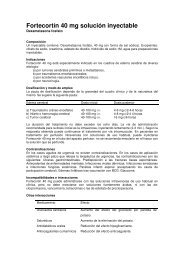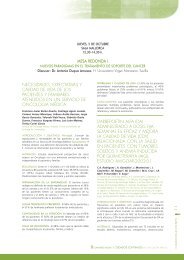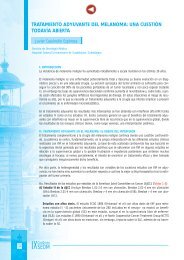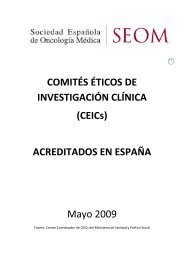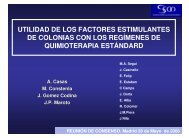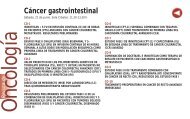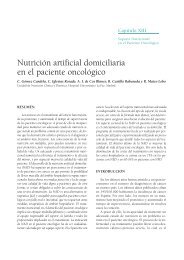Resúmenes de Ponencias - Sociedad Española de OncologÃa Médica
Resúmenes de Ponencias - Sociedad Española de OncologÃa Médica
Resúmenes de Ponencias - Sociedad Española de OncologÃa Médica
Create successful ePaper yourself
Turn your PDF publications into a flip-book with our unique Google optimized e-Paper software.
e useful and many of the same consi<strong>de</strong>rations are shared. However, the differences between the two situations<br />
illustrates that one evaluation solution is unlikely to address all important issues. Many validated instruments<br />
are now available to match most nee<strong>de</strong>d applications.<br />
Is there consensus on the methods for analyzing of quality of life data? The analysis presents several problems.<br />
First, most studies incorporate quality of life into clinical trials in which the primary endpoint is survival.<br />
The problem is that studies are often powered for the survival endpoint, which may not be sufficient<br />
to address quality of life consi<strong>de</strong>rations. Thus, the impact of an intervention on quality of life may be seen<br />
as a less valid evaluation, when in fact it is just as scientifically valid but suffers from having too few patients<br />
enlisted to properly address this aspect.<br />
Another problem in analysis is that of multiple quality of life endpoints. Instruments use many questions to<br />
explore various dimensions of quality of life. It is curious that the criticism of evaluating many endpoints is<br />
often leveled at evaluations of quality of life, but is rarely raised when analyzing toxicity data. In<strong>de</strong>ed, a toxicity<br />
analysis of a new chemotherapeutic agent that failed to assess multiple areas, such as neutropenia, anemia,<br />
thrombocytopenia, hepatotoxicity or nephrotoxicity would be consi<strong>de</strong>red to be incomplete. As in any<br />
trial, the point of interest of the evaluation needs to be stated at the initiation of the trial. A global or summation<br />
quality of life score can be the major point tested while other aspects of interest are examined but<br />
are used to enhance the analysis - not replace it.<br />
Quality of life assessments are troubled by missing data. These occur for two reasons. The first is that data<br />
may not be collected. The second is progression and <strong>de</strong>ath of patients with the disease. Statisticians have<br />
labored over mo<strong>de</strong>ls, which remain controversial, to correct for such missing data. Rather than search for such<br />
adjustments, more acceptable strategies are to consi<strong>de</strong>r the assessment interval as a part of the <strong>de</strong>sign, to<br />
emphasize with investigators the value of the quality of life issue, and to ascertain that these data are collected<br />
with the same vigor that imaging tests and blood studies are gathered. Failure to obtain CT scans is not<br />
tolerated in our studies evaluating response; nor is it acceptable to miss repeat quality of life assessments.<br />
The second source of missing information occurs when a patient goes off study or when a patient dies. It has<br />
been shown that those patients with lower quality of life at the outset of a trial have a <strong>de</strong>creased survival,<br />
have poorer prognostic parameters, and drop out of studies earlier. Treatment may affect quality of life even<br />
after it is completed (such as the <strong>de</strong>layed effects of radiation therapy on pain relief or on radiation pneumonitis).<br />
It is important to continue assessment over the entire time in which the intervention may have an<br />
influence, or for the life of the patient. It may be more useful to envision the entire “amount” of quality of<br />
life of each patient in a trial, rather than examine quality of life at an arbitrary time (perhaps based on a<br />
chemotherapy schedule) in a trial.<br />
How should quality of life data be presented? Is it important to know the percentage of patients with improvement<br />
or with stability? This too may vary according to the patient population. In patients with advanced<br />
disease in comparative trials, improvement may not be the best parameter; maintaining a reasonable level of<br />
quality of life may be <strong>de</strong>sirable with a disease that is progressive when the quality of life was acceptable at<br />
the onset of treatment. Agreements on this type of analysis are necessary as we go forward with more trials<br />
including quality of life assessment. Presentations of results need to be clear and to focus on aspects with<br />
which all oncologists are familiar.<br />
As with all oncology trials, <strong>de</strong>sign of the study has an impact on the interpretation of the results. Single arm<br />
uncontrolled studies of anticancer agents can help generate hypotheses; however, this <strong>de</strong>sign with quality of<br />
life endpoints can be even more difficult to analyze than the response or survival results. Typical supportive<br />
care will contribute to quality of life and palliative results in addition to the anticancer intervention, thus<br />
confounding the analysis. As difficult as using historical controls can be for response and survival results, it<br />
is even more so for quality of life in that few studies are available for comparison. Controlled phase III trials<br />
124<br />
Congreso<br />
IXSEOM



